
By Liel Leibovitz

Israelis, too impatient for leisurely lunches, stuff their midday meals in a pita. Sometimes it’s falafel, sometimes it’s shawarma, and on particularly decadent days, it’s a nobly proportioned and golden schnitzel. But no dish rivets the attention and excites more than sabich, a fried eggplant with a hard-boiled egg, tahini, pickles, and a pungent mango chutney known as amba.
Like everything else in Israel that merits true religious devotion, the origins of sabich are controversial. Some say the dish was a popular breakfast back in Iraq, and that the name is a variation on the Arabic word for “morning,” sabach. Others believe the dish got its name from its originator, an Iraqi Jewish immigrant named Sabich who opened up a small shop in Ramat Gan in 1961 to sell his magical creation.
Either way, the sabich proved to be a stroke of daring genius, a taste, quite literally, of Start-up Nation avant la lettre—cheap to make, quick to assemble, and packed with flavor. So absolute is the dish’s dominance on the local food scene that it taught Israelis, notoriously allergic to orderly lines, how to queue up.
How to order at oved’s, israel’s greatest sabich joint
Givatayim, a sleepy suburb of Tel Aviv, isn’t the sort of place you’d think would be home to a true culinary temple, but drive down its main thoroughfare on any given afternoon and you’ll see cars triple-parked and people lined up quietly, a rarity for Israelis, waiting for the eponymous Oved to work his magic. Other joints can cook up a decent sabich, but only Oved can put on a show, turning the assembly of fried eggplant, tahini, and a hard-boiled egg in a pita into something halfway between a Broadway show and a pagan ritual. When it’s finally your turn, Oved will eye you and ask one crucial question: What’s the score in the Derby? The Derby is the annual match between Tel Aviv’s two rival soccer teams: Hapoel, which wears red uniforms, and Maccabi, decked out in yellow. What Oved is really asking is for you to tell him how much schug and how much amba you’d like in your pita: schug, a Yemenite hot pepper spread, is red, and amba, an Indian mango chutney, is yellow. Tell Oved that the Derby was tied one to one, and you’ll get a spoonful of each. Say Maccabi beat Hapoel three to nothing, and you’ll get a pungent but not too spicy sandwich. Stare Oved in the eye uncomprehendingly, and fifty irate and hungry Israelis standing behind you on line will tell you exactly what they think about your inability to make a decision.
Liel Leibovitz
Sabich
by Einat Admony
Serves 4 to 6
2 large eggplant, stem ends trimmed
Kosher salt
Canola oil, for frying
1 cup (145 grams) finely chopped unpeeled cucumber
1 cup (240 grams) finely chopped tomato
3 tablespoons (12 grams) finely chopped fresh parsley
3 tablespoons (18 grams) chopped scallions (optional)
Freshly ground black pepper
4 to 6 pita loaves
Huevos Haminados or hard-boiled eggs, thinly sliced
Peel strips of skin lengthwise off the eggplant ¼ inch (6 millimeters) apart. Slice the eggplant into ¼-inch-thick (6-millimeter) rounds and generously salt each piece. Place the eggplant in a colander in the sink to drain for about 1 hour.
Heat ¼ inch (6 millimeters) of canola oil in a deep skillet until it reaches about 375ºF (190ºC). Pat the eggplant dry with a few sheets of paper towels. Working in small batches, fry the eggplant in the hot oil until golden brown. Transfer the fried eggplant to paper towels to drain and set aside.
Toss together the cucumber, tomato, parsley, and scallions (if using) in a large bowl until well combined. Season the Israeli salad with a little salt and pepper and set aside.
To assemble the sabich, cut an opening at one end of a pita bread to make a pocket. Smear the inside of the pita pocket with hummus, then place a spoonful of the Israeli salad at the bottom. Add one slice of fried eggplant, a few slices of the egg, and then another spoonful of the Israeli salad. Top it off with another piece of eggplant, a few more slices of egg, a spoonful of amba sauce, and some tahini sauce. Repeat with the remaining pita breads.
If you have any eggplant left over, slather some tahini on it. You can never have too much eggplant.
Makes about 5 cups (1.2 liters)
6 large yellow mangoes
¼ cup plus 2 tablespoons (90 grams) kosher salt
⅓ cup plus 3 tablespoons (110 milliliters) canola oil
1 medium yellow onion, finely chopped
¾ cup (132 grams) mustard seeds
¼ cup (32 grams) cumin seeds
2 tablespoons (14 grams) sweet Hungarian paprika
1 tablespoon (6 grams) ground fenugreek
1 tablespoon plus 1 teaspoon (8 grams) ground turmeric
1 tablespoon (5 grams) coriander seeds
12 garlic cloves, finely chopped
½ cup (120 milliliters) white wine vinegar
Peel the mangoes and cut them into strips about the size of your pinky. Salt them thoroughly and place them in a large canning jar or glass baking dish. Cover tightly and allow to ferment for 5 days, preferably in the hot sun.
After 5 days, drain the mangoes in a colander set over a bowl; reserve the juices. Scatter the mangoes over a baking sheet and allow them to dry for 4 to 5 hours.
Heat 3 tablespoons (45 milliliters) of canola oil in a large pot over medium heat. Add the onion and cook, stirring, until golden brown, about 7 minutes. Add the mustard seeds, cumin seeds, paprika, fenugreek, turmeric, coriander seeds, and garlic. Cook, stirring, for 2 minutes, then add the reserved mango juices. Bring to a simmer, then remove from the heat. Stir in the vinegar and mangoes until well combined. Let the mixture cool to room temperature.
Transfer the cooled mango mixture to a food processor and pulse just until the mangoes are finely chopped. You’re looking for a chunky sauce rather than a puree. Transfer the amba sauce to a jar with a tight-fitting lid and top off with the remaining ⅓ cup (120 milliliters) oil.
This sauce will keep in the refrigerator for at least 6 months.
Makes about 1½ cups (360 milliliters)
½ cup (120 milliliters) tahini
½ cup (120 milliliters) water, plus more as needed
⅓ cup (80 milliliters) fresh lemon juice
1 garlic clove
2 teaspoons kosher salt
Combine the tahini, water, lemon juice, garlic, and salt in a food processor. Process until smooth and creamy.
By Jeffrey Yoskowitz
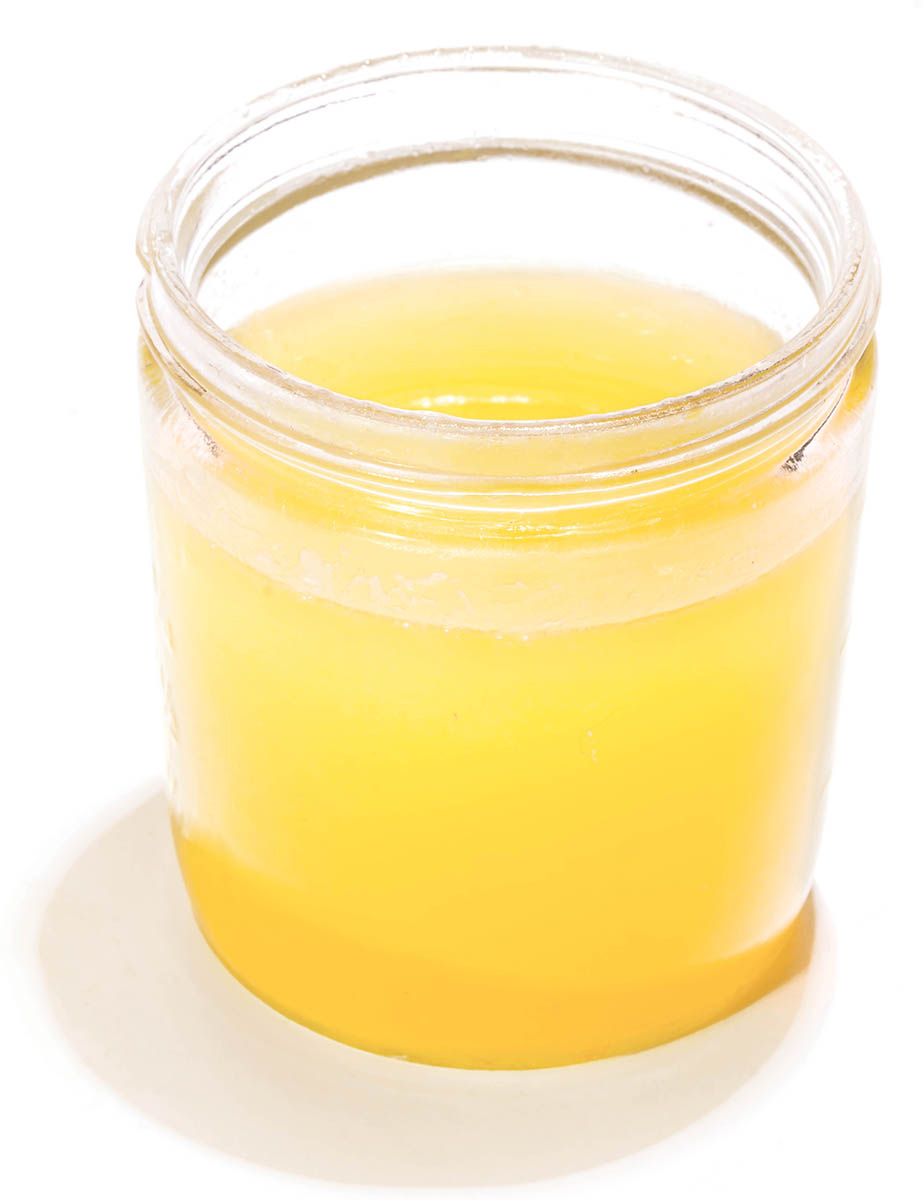
Schmaltz, or rendered poultry fat, was once considered so valuable to Jews in Eastern and Central Europe as a critical cooking fat that they stored it in vessels secured with padlocks. For most of the ’80s, ’90s, and aughts, however, you couldn’t give the stuff away.
Central and Eastern European Jews once cooked nearly exclusively with butter and schmaltz: the yin and yang of the kosher kitchen. For fleishig meals (which include meat), especially in late fall, winter, and spring, schmaltz was the go-to. The advent of vegetable and canola oils and new products like Crisco vegetable shortening didn’t help. The twentieth century may be known for an intellectual flourishing of the American Jewish community, but it should also be known as the century that rendered flavorful Jewish dishes and desserts a distant memory.
I didn’t cook with schmaltz until I was in my twenties. As soon as I began rendering my own from chicken or goose fat, cooking with schmaltz added new layers of flavor and new depths to the Ashkenazi dishes I began to prepare. I felt like my parents and teachers had lied to me about the dreariness of Jewish food. “Jewish cooking today has a reputation for blandness, not entirely unearned,” Jane Ziegelman writes in 97 Orchard, her impressive culinary history of the tenements on the Lower East Side. “A hundred years ago, however, the label would have never stuck.” The disappearance of schmaltz isn’t the only reason for the poor reputation of Jewish food these days, but it’s a pretty obvious one.
Thankfully, due to the erosion of accepted midcentury nutritional dogma, saturated fats are considered “in.” And, just like that, schmaltz—and the distinctly Jewish flavors it bestows—is again on the menu.
Makes ⅔ cup (160 milliliters)
1 pound (455 grams) chicken fat and skin, collected from 3 to 4 pounds (1.4 to 1.8 kilograms) chicken thighs
1 teaspoon kosher salt
3 tablespoons (45 milliliters) cold water
1 large onion, halved lengthwise and thinly sliced (about 2 cups)
Wash the chicken fat and skin in cold water, drain well, and blot dry with a paper towel. Cut the fat and skin into ½-inch (1.5-centimeter) pieces. To make it easier to cut, freeze the chicken fat and skin for at least 2 hours before cutting.
Place the chicken fat and skin in a large skillet and season with ½ teaspoon of the salt. Add the water and bring to a simmer over medium heat. Reduce the heat to low and cook, stirring occasionally and scraping the bottom of the pan to loosen any browned bits, until the water has evaporated, the fat starts to render, and the pieces of fat and skin start to brown, curl up, and shrink to about half their size, about 30 minutes.
Add the sliced onion and the remaining ½ teaspoon salt and cook until the onion softens and caramelizes, about 35 minutes. Lower the heat if needed to prevent the onion or chicken skin from overbrowning, which will affect the color of the schmaltz (it should be golden).
Strain the schmaltz through a fine-mesh strainer set over a large bowl; set the solids aside (see Note). Use the schmaltz immediately, or let cool to room temperature, then transfer to a jar with a lid and refrigerate. The schmaltz will keep in the refrigerator for 3 to 4 days or in the freezer for up to 2 months.
NOTE: The solids in the strainer are the gribenes. Eat them as a snack, add them to chopped liver, or sprinkle them over salad. They will keep in an airtight container in the refrigerator for 3 to 4 days or in the freezer for up to 2 months.
By Wayne Hoffman

Only two kinds of people truly love seltzer: Jews and clowns.
Clowns spray it to get a laugh; Jews don’t need to—we have good timing. But for Jews, seltzer is not to be wasted. “Seltzer is for drinking, not for spraying,” as Rabbi Hyman Krustofsky, voiced by Jackie Mason, explained to his son, Herschel, on The Simpsons. More diet than diet cola, more bubbly than “bubbly,” it’s the thing that turns delicious but goyish chocolate milk into a proper egg cream.
The “2-cents plain” costs a lot more than it used to, though, and that’s a problem for people who go through a lot of seltzer. (Herschel Krustofsky, for instance, grew up to become Krusty, a Jew and a clown; he rigged up a spritzer to his doorbell, so you can imagine his seltzer bills.) The solution comes from what was the hottest kitchen appliance of the twenty-first century until the Instant Pot came along: the SodaStream, which turns every kitchen into a soda fountain. Made in Israel, of course. No joke.

By Liel Leibovitz
So what if the Moroccans make it, too. Never mind that the Tunisians eat it for breakfast each weekend, or that it delights the Greeks and satiates the Algerians: Shakshuka is Israeli now. In fact, it’s Israeli because, not in spite, of its widespread popularity across the Middle East.
As Jews huddled for safety in their biblical homeland, fleeing violence in Rabat or Tunis or Algiers, they could take comfort in one thing: simmering onions, peppers, and tomatoes, topped with a couple of eggs, cooked in a skillet and consumed with a fresh loaf of white bread. It was what home tasted like, no matter where home happened to be.
The ingredients are so basic and the flavors so recognizable that these days, if you want to evoke the mists of the Mediterranean in Boston or Berlin, all you have to do is whip up a skillet of shakshuka. For a true melting-pot experience, some add griddled Cypriot halloumi cheese.
by Einat Admony
Serves 4 to 6
3 tablespoons (45 milliliters) canola oil
2 medium yellow onions, chopped
1 large green bell pepper, cored, seeded, and chopped
1 large jalapeño, cored, seeded, and chopped
7 garlic cloves, finely chopped
¼ cup (60 milliliters) tomato paste
1 (28-ounce/793-gram) can whole peeled tomatoes, crushed by hand
1 bay leaf
2½ tablespoons (32 grams) sugar
1½ tablespoons (23 grams) kosher salt
1 tablespoon (7 grams) sweet Hungarian paprika
1 tablespoon (6 grams) ground cumin
1½ teaspoons freshly ground black pepper
1 teaspoon ground caraway seeds
½ bunch Swiss chard, stemmed, leaves chopped, or spinach
8 to 12 large eggs
Heat the canola oil in a large skillet over medium heat. Add the onions and cook until translucent, 5 to 10 minutes. Add the bell pepper and jalapeño and cook until just softened, 3 to 5 minutes. Stir in the garlic and tomato paste and cook, stirring, for 2 minutes more.
Slowly pour in the tomatoes. Stir in the bay leaf, sugar, salt, paprika, cumin, black pepper, and caraway and simmer for 20 minutes. Layer the Swiss chard leaves on top.
Crack the eggs into the tomato mixture. Cover and simmer for about 10 minutes, or until the whites of the eggs are no longer translucent.
By Michael Wex

When I was growing up among Polish Jews in western Canada, the main shul shot was rye. Crown Royal on special occasions. Once in a while, scotch. So what made slivovitz, a plum brandy rough enough to make Frankie Valli krekhts (groan) like Tom Waits, so Jewish, even to those of us who rarely drank it? It embodied a worldview. As my grandfather once put it, “You don’t have to like it. You just have to remember that it’s the one thing you buy in a store that doesn’t taste worse on Pesach.” It didn’t have to be good; it only had to be not worse.
What can you say but amen?
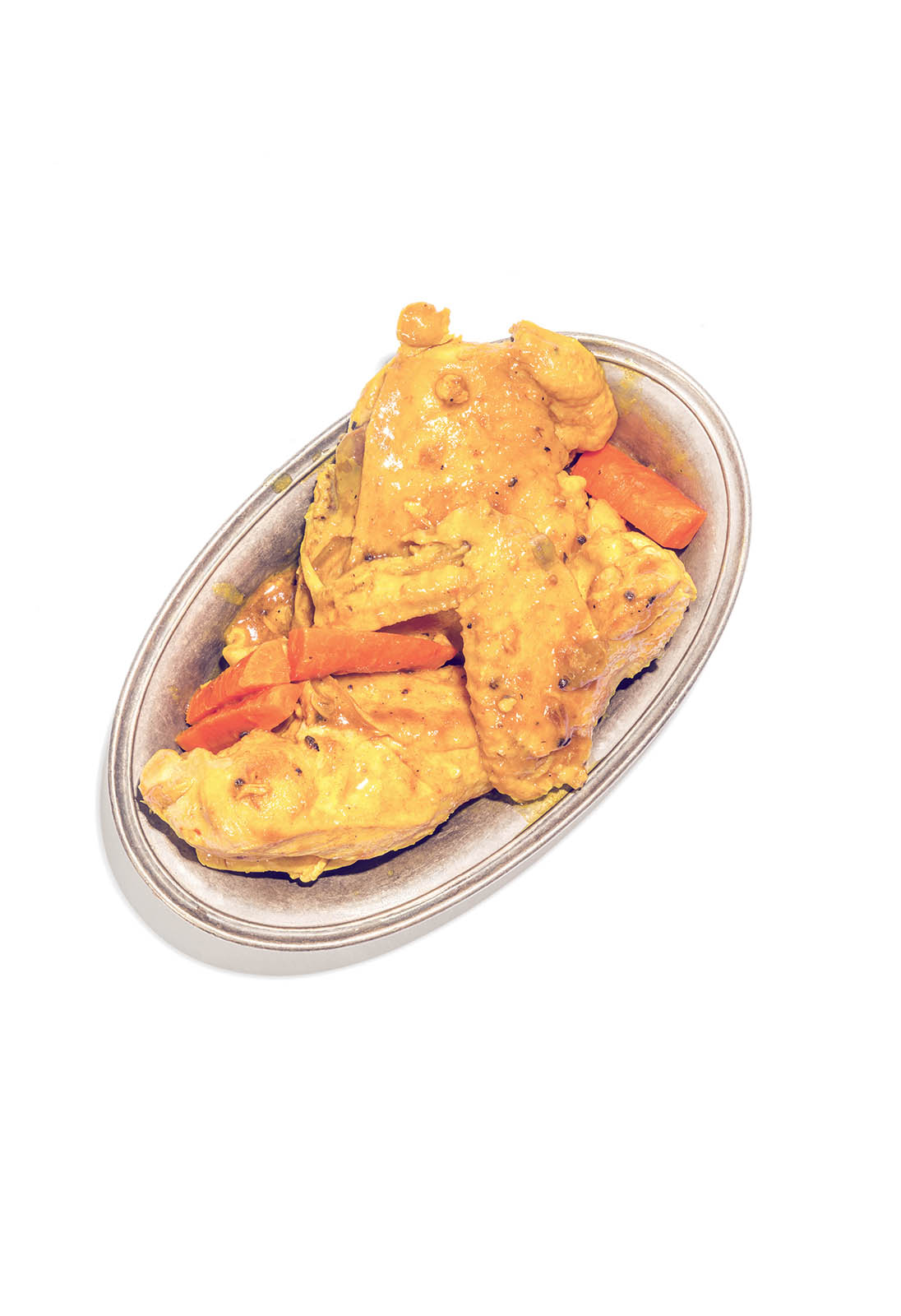
By Rachel Figueroa de Zimmerman
Every Friday, the aroma of simmering onions, cumin, turmeric, peppers, and garlic wafts up from Jewish stovetops throughout the world. For the people in these homes, sofrito—a dish with roots dating back to the Roman Empire—serves as a reminder of the impending Sabbath.
For non-Jews in Puerto Rico and other parts of Latin America, sofrito refers to only the sauce, or a base used for cooking. For Sephardim, sofrito is the final product—the full dish. As a Puerto Rican Jew, I keep a Tupperware full of sofrito in my freezer that I use to make . . . sofrito.
Sofrito can be made with almost anything. The word sofrito comes from the Spanish sofreír, which means “to fry lightly.” As such, most sofrito recipes involve sautéing a protein, peppers, potatoes, and herbs and spices in olive oil. Some recipes even call for deep-frying some of the ingredients before incorporating them into the stew. In a lot of ways, sofrito is like cholent. It’s something you can cook and keep heated on Friday and eat throughout Shabbat. With sofrito, however, the cooking time is much shorter. If you’re feeling spicy, you can throw some cumin, coriander, and other spices into your cholent and have yourself a sofrito-fusion Sephardic Sabbath.
But how did this humble dish of Spanish origin grow to become one of the universal culinary truths—one that ties together kitchens all throughout the Sephardic Diaspora?
Well, in 1492 Columbus sailed over here with a bunch of Jews—refugees from the quarter-million-strong community that had just been expelled from Spain. In 1536, the Portuguese followed suit with an inquisition of their own. With that, the Sephardic community, its culture, and its cuisine spread across the globe. Sofrito went from Iberian to international.
The traditional recipe for sofrito? It depends on whom you ask. One person might tell you that the base for a traditional sofrito contains tomatoes. A second might tell you that since tomatoes are a New World fruit, they don’t belong in there at all. The first will then retort that the New World was colonized over five hundred years ago, and that’s long enough for something to become a tradition.
As the old saying goes, “Two Jews, three sofritos.”

Sofrito
Serves 4
3 tablespoons (45 milliliters) olive oil
1 (4-pound/1.8-kilogram) chicken, quartered, plus wings
Kosher salt and freshly ground black pepper
1 large onion, halved and thickly sliced
5 or 6 garlic cloves
4 medium carrots, cut into 1½-inch (4-centimeter) pieces
1 large celery stalk, finely diced
Juice of 1 lemon
1 teaspoon ground turmeric
4 cardamom pods, cracked
1 cup (240 milliliters) water
Cooked rice, for serving
Heat the oil in a large pan over medium-high heat until almost smoking.
Meanwhile, pat the chicken dry with paper towels and season it generously with salt and pepper. Carefully (to avoid the spattering oil) place the chicken flat in the pan, skin-side down, and sear until golden brown, about 5 minutes. Transfer the chicken to a plate and set aside.
Add the onion and garlic to the pan and cook, stirring, until the onion starts to take on color, about 5 minutes. Add the carrots and celery and cook, stirring, until the celery begins to soften, about 2 minutes.
Return the chicken to the pan, skin-side up. Add the lemon juice, turmeric, cardamom, 2 teaspoons salt, ¾ teaspoon pepper, and water and bring to a boil. Reduce the heat to low, cover, and cook, turning the chicken over every 5 minutes or so and adding water as necessary, until the chicken is very tender, about 45 minutes. There should be a good amount of sauce.
Transfer the chicken to a plate, cover to keep the chicken moist, and simmer the sauce until it thickens, about 20 minutes more. Return the chicken to the pan, cover the pan, and simmer for 10 minutes to rewarm the chicken. Serve hot, accompanied by cooked rice.

By Gil Hovav
Let’s face it: Israelis think they invented everything. Everything! Stents? It was us. Cherry tomatoes? Us again. Disk on key? Yup. Sliced bread? Sure. And don’t forget rice (and God!).
But when it comes to soup mandel, we may have taken it a bit too far. While the Yiddishe name implies that this godly creation was made for chicken soup, which we invented (hey, we invented chickens!), the old mameloshen name also means that the roots of the mandel are in Europe and not Israel.
Well, this may be the case, but we Israelis have improved it. Our shkedei marak (“soup almonds” in Hebrew) are smaller, baked and not fried, and so shiny yellow that you may want to put on sunglasses before you eat them. Up until not too long ago, this was due to frightening contents of something that gave Israeli shkedei marak a lovely look of nuclear waste. Now it is all natural (but still more than 25 percent fat)—seven thousand tiny, crunchy squares of yellow happiness in every package.
Stella D’oro Swiss Fudge Cookies
By Ian Frazier
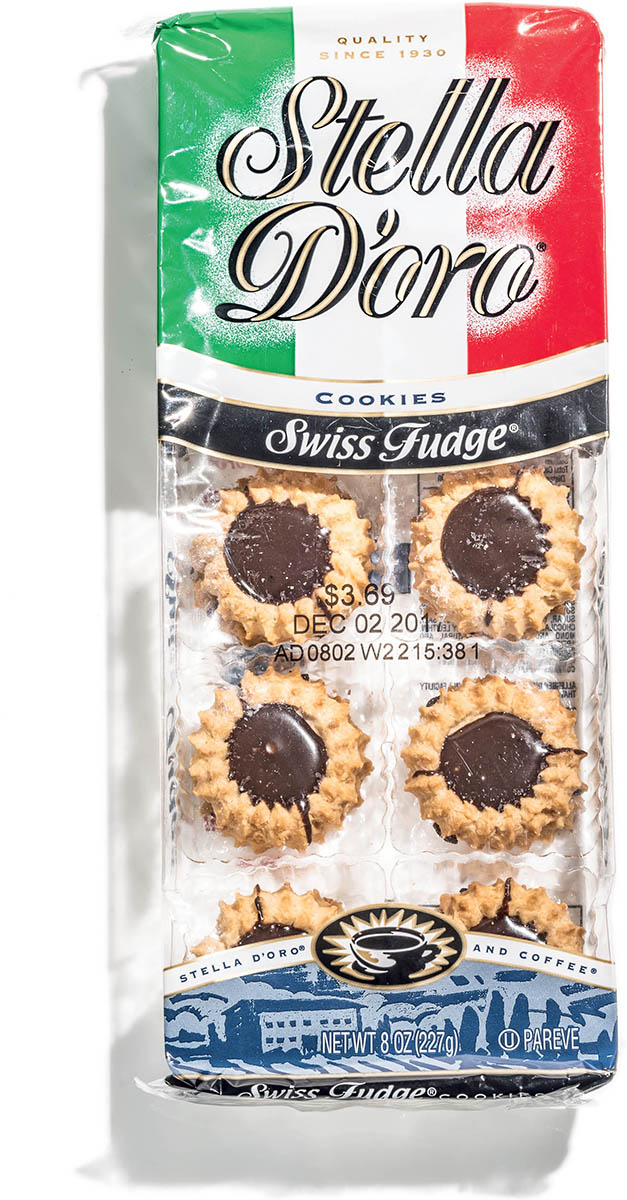
In 1930, 49 percent of the 1,265,258 people who lived in the Bronx were Jews. In certain parts, such as along Tremont Avenue, the figure was as high as 80 percent. A market for a certain kind of cookie was just sitting there—hundreds of thousands of cups of tea and coffee with nothing quite right to go with them. The Stella D’oro Bakery, a Bronx-based, family-owned company, saw the need and began to make Old World, less-sweet cookies from recipes that contained no dairy products. In America, the land of milk and cookies, Stella D’oro baked for the tea- and coffee-drinking, kosher-keeping connoisseur. It succeeded gigantically. The Stella D’oro Swiss Fudge Cookie—about the size of a silver dollar, with a floral shape and a dark chocolate center that resembled the center of a sunflower—became the most Jewish cookie ever made.
By the 1950s, Stella D’oro had built a factory at the corner of 237th Street and Broadway, in the Kingsbridge section of the Bronx. The smell of baking cookies levitated the neighborhood for miles around. Depending on the wind and what was in production that day, you could smell the cinnamon, chocolate, and licorice (for the anisette toast) two el-train stops away.
The Zambetti family, which owned the company, prospered through two generations. In the 1980s, Stella D’oro was doing $65 million of business a year. Workers received top wages and put their kids through college. A Zambetti grandson, Marc, who was in his twenties, prepared to take the helm. Then, on October 17, 1989, Marc died in the San Francisco earthquake. The family sold the company, which soon became part of Kraft Foods. New management decided that not using dairy products was too expensive, so it changed the recipe and removed the pareve label. Rabbis wrote outraged letters. Sales fell by almost 50 percent. The old recipe was restored and the label put back on. Later, a hedge fund bought the company and cut salaries. The workers went on strike for eleven months but lost their jobs anyway when a North Carolina–based snack-food company bought Stella D’oro and moved it out of the Bronx. Stella D’oro’s delicious baking smells now drift forlornly across the fields and through the woods of semirural Ashland, Ohio. The packages still say “pareve,” and the cookies still taste the same. That the Swiss Fudge Cookie has its own story of suffering, exile, and survival makes it even more Jewish, I believe.
By Michael Wex
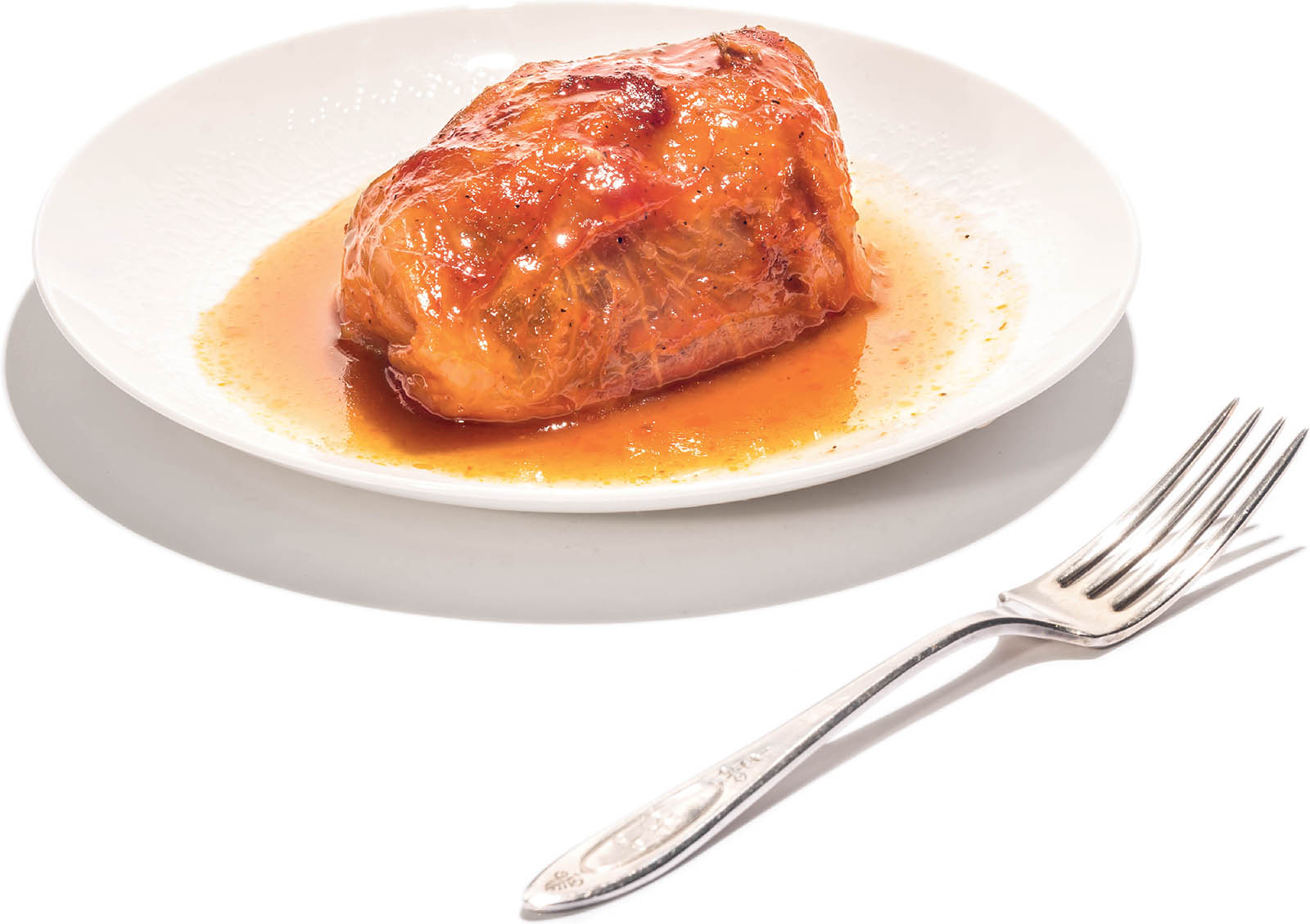
Poles eat it, Czechs eat it, other Slavs and even Teutons eat it, but that doesn’t alter the fact that stuffed cabbage taught me the difference between treyf and goyish, the not-kosher and the not-Jewish. While trying to ease my way into eating pork, I ordered some cabbage rolls in a lard-in-everything-but-the-coffee Hungarian restaurant near the University of Toronto, but the sour cream atop those haleptses was so outrageous, so viscerally wrong as to drive me from my dreamt-of treyf. I bolted from the restaurant, more kosher than when I went in. Khazer was khazer, but for this, there were no words.
Makes about 16 rolls; serves 6
1 head green or savoy cabbage (about 4½ pounds/2 kilograms)
3 quarts (3 liters) boiling water
3 tablespoons (45 milliliters) olive oil
1 medium onion, chopped small
1½ teaspoons kosher salt, plus more as needed
3 medium carrots, parsnips, or a combination, shredded
1 celery stalk, finely chopped
Freshly ground black pepper
½ cup (110 grams) uncooked white rice
½ cup (75 grams) golden raisins
3 tablespoons (45 milliliters) tomato paste
1 pound (455 grams) ground beef
3 cups (720 milliliters) pureed tomatoes or tomato juice
Carve the core out of the cabbage using a sharp knife; leave the cabbage whole. Transfer the cabbage, cored-side up, to a large bowl and pour the boiling water over it. Cover and let the cabbage soften, about 15 minutes. Turn the cabbage over so the cored side is now on the bottom, cover, and let sit for 15 minutes more.
Heat the olive oil in a large skillet over medium heat. When the oil is shimmering, add the onion and cook, stirring, until softened, about 5 minutes. Season with a small pinch of salt. Add the carrots and/or parsnips and the celery and cook, stirring, until softened, about 5 minutes more. Season with another pinch of salt and some pepper, then transfer to a large bowl. Add the rice, raisins, and tomato paste to the bowl. Stir until the ingredients are mixed and let cool. Add the meat, season with 1½ teaspoons salt and more pepper, and mix to combine.
Drain the cabbage. Pull off the large leaves and cut out the large vein-like center rib. If the leaves are very large, you can halve them; if the leaves are smaller, remove the vein by partially cutting into the leaf. Pat the leaves dry with paper towels. Spoon about ¼ cup (60 grams) of the filling onto each leaf, on the part of the leaf that is the thinnest and most tender (the part farthest from the base of the leaf), then roll it up, tucking the sides in. Arrange the rolls, seam-side down, in a large, wide pot. If you need to layer the rolls, that’s OK. Add the pureed tomatoes, then add 1 to 2 cups (240 to 480 milliliters) water to the puree container and swirl it around. Add enough liquid from the puree container to just cover the rolls (you may not need to add it all).
Set the pot over medium heat and bring to a lively simmer. Reduce the heat to low, cover, and simmer until the cabbage leaves become translucent and almost glass-like with shine, about 1 hour 15 minutes. Serve the rolls warm, with the sauce spooned over the top. Stuffed cabbage freezes beautifully—tightly cover the rolls and freeze for up to 3 months.
By Yotam Ottolenghi

A greasy, tacky, sugary oddball, injected with smooth, gummy red jam that hasn’t seen a single berry in its life: This could easily be shortlisted for the worst Jewish foods, quite possibly topping the list (though for that, we have gefilte fish).
In reality, a sufganiyah can be as good or as bad as the quality of storytelling of the Hanukkah tale: a compelling plot of lights and splendor or a dubious account of a highly improbable episode. A good sufganiyah, when you come across it, is a magnificent miracle of billowy lightness accentuated by a creamy or fruity filling. Together, they form a truly irresistible package—against all odds!
why jews eat fried foods on hanukkah
Hanukkah, Hebrew for “dedication,” is an eight-day-long celebration commemorating the rededication of the Second Temple in the second century BCE and the Maccabees’ uprising against the Greeks. After defeating Antiochus and his Hellenizing forces, the Maccabees—Mattathias the Hasmonean and his five sons: Jochanan, Simeon, Eleazar, Jonathan, and Judah, who led the charge—recaptured the Temple, and set out to purge it of idols.
According to the Talmud, the Maccabees wished to light the Temple’s menorah, a traditional candelabrum that customarily burned through the night in Judaism’s holiest place, but discovered just enough oil to last for one day. Miraculously, however, the oil burned for eight days, a wonder we commemorate by lighting candles for eight nights. And, of course, by eating fried foods, like latkes and sufganiyot.
Sufganiyot
by Joan Nathan
Makes about 36 doughnuts
1 tablespoon (10 grams) active dry yeast
3 tablespoons (38 grams) granulated sugar
¼ cup (60 milliliters) water
½ cup (120 milliliters) lukewarm milk
1 large egg
1 large egg yolk
Pinch of kosher salt
Finely grated zest of 1 lemon
3½ cups (435 grams) unbleached all-purpose flour, plus more for dusting
3½ tablespoons (48 grams) unsalted butter, at room temperature
Vegetable oil, for deep-frying
1 cup (240 milliliters) raspberry, apricot, strawberry, or any flavorful jam, dulce de leche, Nutella, or lemon curd
Confectioners’ or granulated sugar, for rolling and dusting
In a large bowl, dissolve the yeast and 1 tablespoon (12 grams) of the granulated sugar in the water, then stir in the milk.
Add the egg, egg yolk, salt, lemon zest, flour, remaining 2 tablespoons (26 grams) granulated sugar, and the butter. Mix with your hands until a dough forms, then knead the dough on a clean countertop until the dough is sticky and elastic.
Transfer the dough to a clean, lightly oiled bowl, cover with plastic wrap or a clean kitchen towel, and let rise in a warm place for at least 1 hour, until doubled in volume. If you want, you can let the dough rise overnight in the refrigerator; let it come to room temperature before rolling and cutting.
Dust a clean work surface with flour. Roll the dough out to a ½-inch (1.5-centimeter) thickness. Using the top of a glass or a biscuit cutter, cut out rounds about 2 inches (5 centimeters) wide and let rise for 30 minutes.
Heat at least 2 inches (5 centimeters) of vegetable oil in a heavy-bottomed pot over medium heat until it reaches 375ºF (190ºC) or is about to bubble.
Drop the doughnuts, 4 or 5 at a time, into the hot oil. Cook for 2 to 3 minutes on each side, turning when brown. You should see diminished bubbling and hear less sizzling when the doughnuts are ready to turn. Transfer to paper towels to drain. Repeat to fry the remaining doughnuts.
Using a pastry or cupcake injector (available at cooking stores and online), fill each doughnut with about 1 teaspoon of jam. Roll the sufganiyot in confectioners’ or granulated sugar and serve immediately.
Sugar Cereals for Shabbos Morning
By Menachem Butler
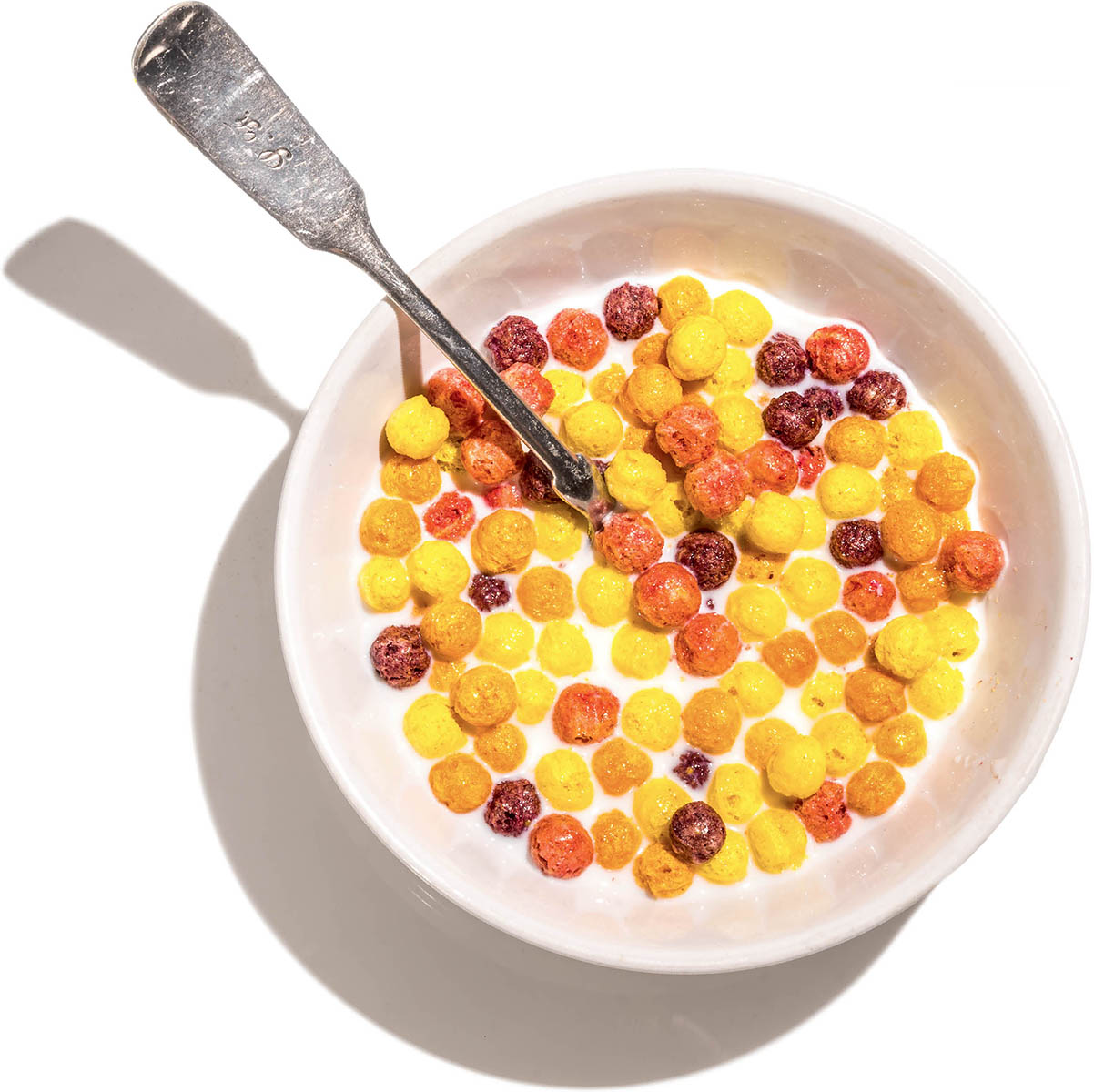
The smell of freshly baked challah reminds me of my mother’s challah, which she lovingly baked for each Shabbos when I was growing up. But it is another Shabbos delicacy from my childhood that taught me to honor the Sabbath with unique food. I refer to Rice Krispies, Honey Nut Cheerios, and other sugar cereals that my siblings and I (and, I assume, many others who grew up in the Orthodox Jewish community) were permitted to eat only on Saturday morning—as a replacement for the hot breakfasts that couldn’t be cooked because of Sabbath prohibitions. While we woke up early to attend shul, it was unimaginable that we would leave the house until after we had eaten our special treat. As I got older and replaced eating sugar cereals before davening with the kiddush that followed, I remember with fondness my youthful excitement at awaking each Saturday morning to observe and remember the Sabbath by making it holy . . . with Froot Loops.
By Daphne Merkin
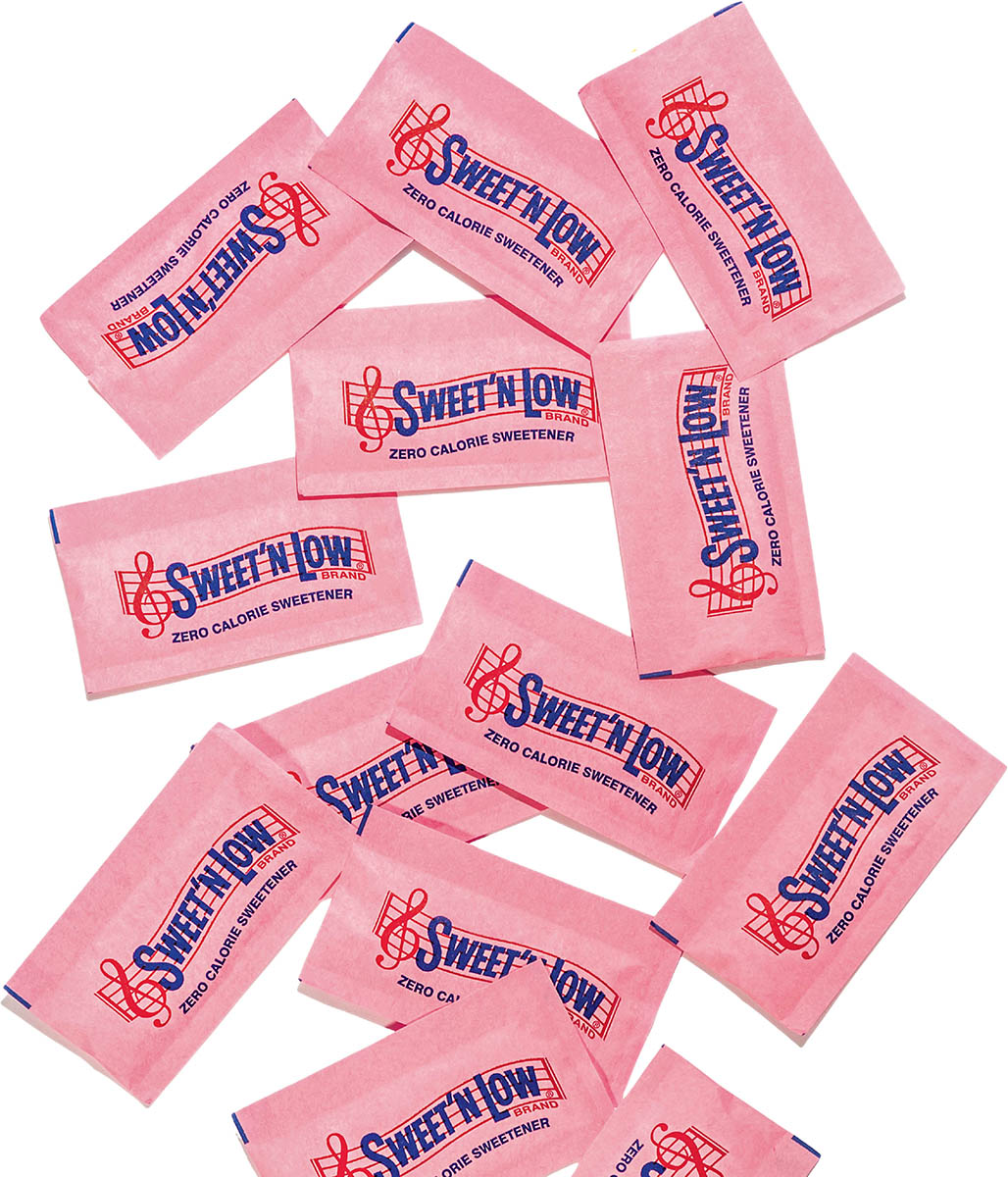
These little pink packets with a musical staff logo containing powdered substitute sugar made largely from granulated saccharin are the perfect answer to fooling one’s sweet tooth. Not for purists or the health-conscious, but for every woman who wanted to have her cake or coffee without sacrificing her waistline. First introduced in 1957 by a Jewish father-and-son team, over 500 billion packets have been produced to date. Think of them as a wink, a sly way of bypassing the confinement of the caloric laws with no loss in taste—an eruv guarding against fatty expansion.
Even today, the iconic pink packet stands its ground in a crowded field that has expanded to include natural sweeteners like Splenda and Truvia. There’s nothing like a classic.
History Lesson
My grandpa Benjamin Eisenstadt, a solidly built Brooklyn business owner, was always on a diet. In the 1950s, this meant skipping dessert. In place of sugar, he used cyclamate pills—thirty to fifty times sweeter than sucrose—which he dropped into his coffee. But Ben craved sugar, less for the taste than for the way it felt on the tongue, how it rained into his ice tea. He wondered why, though we had the automobile and the jet plane, there was no good sugar substitute. It gave him an idea, which dovetailed with another. Ben owned a small factory, which he’d converted from a family diner, where, in addition to sugar (Ben also invented the sugar packet, which is another story), he packed soy sauce and coins, but he dreamed of having his own product. In 1956, working with his son, Marvin, as well as a chemist, Ben concocted dozens of versions of fake sugar. When he found just the right mix—saccharine is the main ingredient—he named it after the Tennyson poem “Sweet and Low.” Aunt Barbara came up with the design—a musical clef rising toward cost-free exuberance. The pink packet was made to stand out amid a sea of sugar white. Ben started by selling the fake sugar to hospitals and pharmacies as a salve for diabetics and the obese. People were soon turning up at the factory, asking to buy it in bulk. Ben had stumbled upon a truth behind every successful business: it turned out that his desire—to remake himself in the shape of the men on the billboards—was shared by millions of others. He’d plugged into the zeitgeist, which made Sweet’N Low ubiquitous and Ben rich. My branch of the family? Well, the short of it is, I’m not rich. The long of it is my father, who while courting my mother had been used as a lab rat, forced to drink cup after cup of fake sugar, upon learning in 1977 that saccharine possibly caused cancer, muttered to himself, “I knew that son of a bitch was trying to kill me.”
Rich Cohen